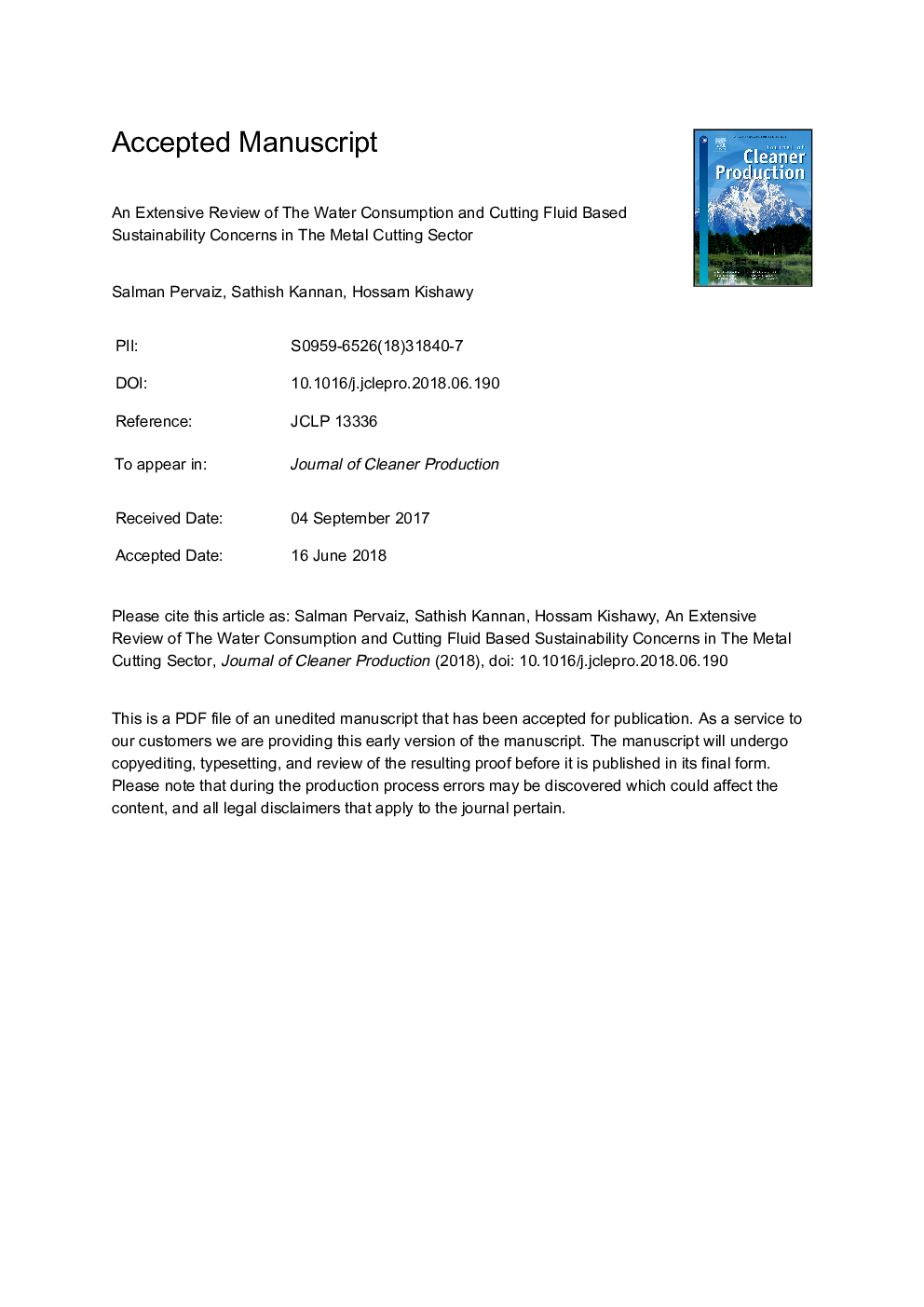| کد مقاله | کد نشریه | سال انتشار | مقاله انگلیسی | نسخه تمام متن |
|---|---|---|---|---|
| 8093727 | 1522056 | 2018 | 46 صفحه PDF | دانلود رایگان |
عنوان انگلیسی مقاله ISI
An extensive review of the water consumption and cutting fluid based sustainability concerns in the metal cutting sector
ترجمه فارسی عنوان
بررسی گسترده ای از مصرف آب و نگرانی های پایداری مایع بر روی مایع در بخش برش فلز
دانلود مقاله + سفارش ترجمه
دانلود مقاله ISI انگلیسی
رایگان برای ایرانیان
کلمات کلیدی
ماشینکاری پایدار، فرایند برش فلز، استراتژی های روانکاری، برش مایعات،
ترجمه چکیده
فرایندهای ماشینکاری از منابع طبیعی به عنوان جریان ورودی استفاده می کنند و در طول فرآیند برش به علت برش بیش از حد ناشی از تغییر شکل پلاستیک و اصطکاک باعث ایجاد گرما شدید می شوند. مقدار بیش از حد تولید گرما در منطقه برش می تواند عملکرد ماشینکاری و عمر محصول محصول را با کاهش عمر ابزار، خراب شدن یکپارچگی سطح و تحمل ابعاد قطعات ماشینکاری کاهش دهد. با توجه به مصرف منابع طبیعی و تولید جریان های خروجی زباله، پایداری فرآیند ماشینکاری مطرح می شود. استفاده از مایع برش در فرایندهای ماشینکاری به عنوان یکی از مهمترین عوامل موثر در افزایش اثرات زیست محیطی محسوب می شود. با وجود مشکل دفع آنها، برش مایعات شامل مقدار زیادی آب برای آماده سازی آنها است. مطالعه حاضر با هدف ارائه یک بررسی سیستماتیک، انتقادی و جامع در مورد اهداف زیر است. (1) تقاضای آب در ماشینکاری، و (2) پیشرفت روانکاری / خنک کاری سازگار با محیط زیست. برای اولین هدف تحقیق در مورد تقاضای آب در فرآیند ماشینکاری، مطالعه، آغاز کامل در مورد چاپ پاک آب در فرآیندهای ماشینکاری را ارائه کرد. برای اهداف دوم، روانکاری و استراتژی های خنک سازی با محیط زیست مناسب بر اساس راه حل ارائه شده توسط مطالعات مختلف برش فلز مورد بحث قرار گرفتند. برای این منظور، مطالعات انجام شده از چند دهه گذشته، مورد توجه خاصی قرار گرفتند. این مطالعه همچنین شامل تأثیر پارامترهای برش و طبیعت متفاوتی از فرایندهای ماشینکاری مانند فرز، چرخش، حفاری و سنگ زنی و غیره تحت روانکاری سبز و استراتژی خنک کننده است. سرانجام، این مطالعه راه حل های بالقوه را برای جایگزینی روش های معمولی خنک کننده و تصمیم گیری های آینده را بر اساس چالش های فعلی مربوط به آن ارائه می دهد.
موضوعات مرتبط
مهندسی و علوم پایه
مهندسی انرژی
انرژی های تجدید پذیر، توسعه پایدار و محیط زیست
چکیده انگلیسی
Machining processes consume natural resources as input streams and generate intense heat during the cutting process due to excessive shearing caused by plastic deformation and friction. The excessive amount of heat generation in the cutting zone can impair the machining performance and service life of the product by reducing the tool life, disturbing the surface integrity and dimensional tolerancing of the machined part. Due to the consumption of natural resources and generation of waste output streams, sustainability of machining process is questioned. Application of cutting fluid in machining processes is considered as one of the major contributor towards higher environmental impact. Despite of their disposal problem, cutting fluids involve generous amount of water for their preparation. The current study aims to provide a systematic, critical and comprehensive review about the following objectives; (1) water demand in machining, and (2) progress of different environment friendly lubrication/cooling strategies. For the first research objective of water demand in the machining processes, the study presented a thorough start-of-the-art about the water foot print involved in the machining processes. For the second research objective, different environment friendly lubrication and cooling strategies were critically discussed based on the solution provided by different metal cutting studies. For this purpose, studies from the last couple of decades were given a special consideration. The study also includes the influence of cutting parameters and different nature of machining processes such as milling, turning, drilling and grinding etc. under different green lubrication and cooling strategies. Finally, the study concludes the potential solutions to replace conventional cooling methods, and recommends future directions based on their associated current challenges.
ناشر
Database: Elsevier - ScienceDirect (ساینس دایرکت)
Journal: Journal of Cleaner Production - Volume 197, Part 1, 1 October 2018, Pages 134-153
Journal: Journal of Cleaner Production - Volume 197, Part 1, 1 October 2018, Pages 134-153
نویسندگان
Salman Pervaiz, Sathish Kannan, Hossam A. Kishawy,
